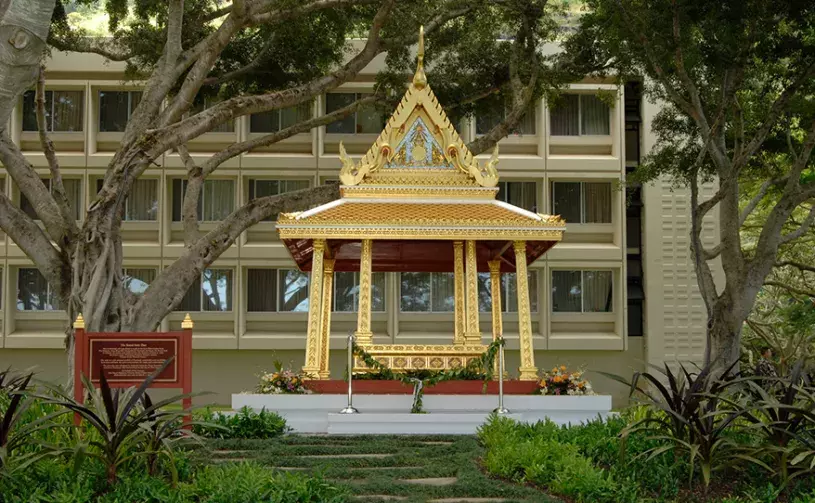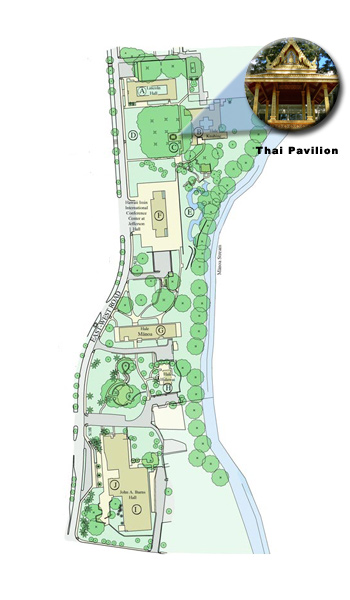

In 1967, as a gesture to extend goodwill and cultural understanding, Their Majesties King Bhumibol Adulyadej and Queen Sirikit of Thailand dedicated a traditional sala —pavilion—to the East-West Center. It was one of only four salas outside of Thailand to bear the Royal Seal and the only one personally dedicated by the king.
The sala is a replica of one built during the reign of King Rama VI (1910-1925). It has been said that as the king sat in the sala one evening, he saw the relics of Buddha passing by. Thus, he gave the sala the proper name, Pratinang Patiharn Tasanai, which means "Throne of the Miracle Vision."
However, due to age and climate conditions, the original sala was reconstructed in 2006 under the auspices of His Majesty. The beautiful new structure, made of hard woods and elaborately carved and painted in gold, was built in Thailand and assembled in Hawai‘i by a crew of traditional craftsmen under the direction of Thai National Artist/Architect Dr. Pinyo Suwankiri.
On March 1, 2008, Princess Maha Chakri Sirindhorn, daughter of King Bhumibol Adulyadej and Queen Sirikit, dedicated the new sala. In her remarks at the dedication ceremony, Her Royal Highness described the king’s intent in gifting the original sala to the East-West Center in 1967 as symbolic meeting place for people from different nations and cultures to come together and exchange knowledge and ideas.
“In the old days, one way of community service or merit-making was to build a pavilion, or a Thai sala,” the princess said. “Its purpose is for any traveler or passerby to rest a while during their journey. A sala is therefore a labor of love. It is free for all travelers coming from different directions. At the sala, travelers may have an opportunity to meet and share their ideas and information with one another. It was therefore His Majesty’s wish to build a sala here at the East-West Center as a symbol of universal hospitality and brotherhood of mankind.”

In 1967, as a gesture to extend goodwill and cultural understanding, Their Majesties King Bhumibol Adulyadej and Queen Sirikit of Thailand dedicated a traditional sala —pavilion—to the East-West Center. It was one of only four salas outside of Thailand to bear the Royal Seal and the only one personally dedicated by the king.
The sala is a replica of one built during the reign of King Rama VI (1910-1925). It has been said that as the king sat in the sala one evening, he saw the relics of Buddha passing by. Thus, he gave the sala the proper name, Pratinang Patiharn Tasanai, which means "Throne of the Miracle Vision."
However, due to age and climate conditions, the original sala was reconstructed in 2006 under the auspices of His Majesty. The beautiful new structure, made of hard woods and elaborately carved and painted in gold, was built in Thailand and assembled in Hawai‘i by a crew of traditional craftsmen under the direction of Thai National Artist/Architect Dr. Pinyo Suwankiri.
On March 1, 2008, Princess Maha Chakri Sirindhorn, daughter of King Bhumibol Adulyadej and Queen Sirikit, dedicated the new sala. In her remarks at the dedication ceremony, Her Royal Highness described the king’s intent in gifting the original sala to the East-West Center in 1967 as symbolic meeting place for people from different nations and cultures to come together and exchange knowledge and ideas.
“In the old days, one way of community service or merit-making was to build a pavilion, or a Thai sala,” the princess said. “Its purpose is for any traveler or passerby to rest a while during their journey. A sala is therefore a labor of love. It is free for all travelers coming from different directions. At the sala, travelers may have an opportunity to meet and share their ideas and information with one another. It was therefore His Majesty’s wish to build a sala here at the East-West Center as a symbol of universal hospitality and brotherhood of mankind.”

